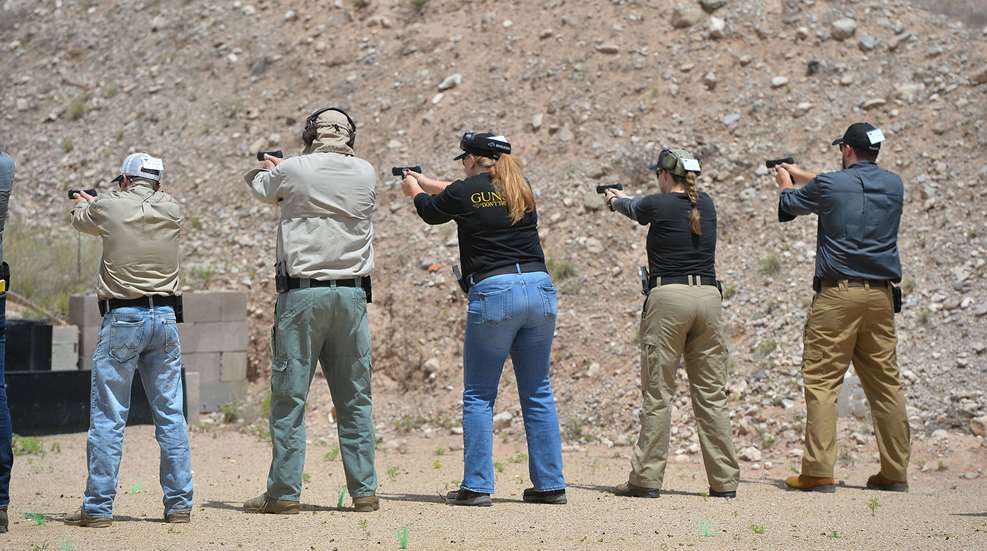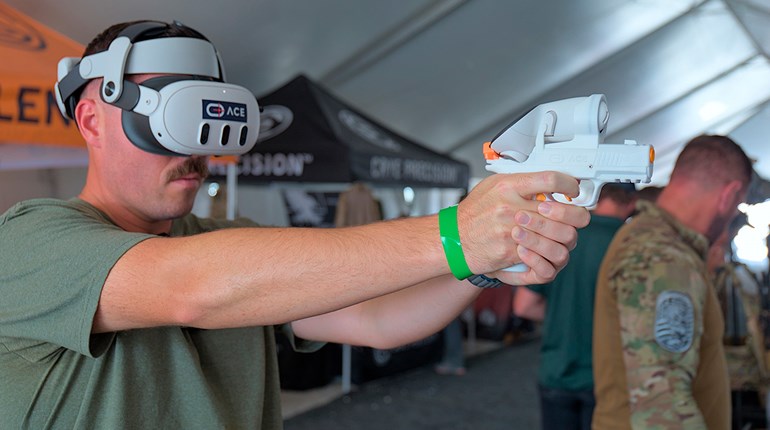
Moving with a gun seems simple, right? Just … you know, move. Walk, or whatever. However, there’s a specific way to move that will come in handy in certain circumstances.
We’re not talking about 3-gun competition where you’re running from target to target; that’s a specialized kind of movement where speed counts and you’re not defending yourself from anything. And we’re not talking about most types of hunting, where you might be walking through a cut field waiting for a dog to point birds or stalking through the woods looking for deer. Again, those aren’t defensive situations, and there are specific carry methods that work safely and still let you shoot pretty quickly if needed.
Rather, what we’re talking about in this article is a technique I learned at Gunsite Academy, useful for times when your gun is drawn and the safety is off, because you’ve either just fired or you think you might be about to fire, but you don’t have a target yet. Maybe you’re hunting and encountering dangerous game, and you’re not sure if that grizzly bear ran to the next county or if he’s waiting just beyond the bend. Maybe you heard a bump in the night and you’re forced to clear your home (which you should not do unless you have to). Maybe you were accosted by multiple assailants and you’re not sure if the buddies of the guy you just had to shoot are waiting for you in the next alley.
Whatever the reason, the immediate danger is over, but the coast is not entirely clear—trouble could pop back up at any moment, and you can’t put the gun away until you know everything is safe. But you also can’t just stand there in one spot; you have to get to your truck, or to your kids on the other side of the house, or wherever else you’ll find safety.
The trick here is you want to remain ready to re-engage a target with absolutely no hesitation the moment it’s required. You’re not in a big hurry, but it’s important that you can:
- See where you’re going
- Maintain a position you can shoot from
- Be stable enough that you won’t stumble or be easily pushed over if you’re attacked.
We address those with a move Gunsite instructor Il Ling New calls “Big Step, Little Step.” Maintain a fighting-style firing stance, with your feet about shoulder-width apart and the foot on your non-dominant side a little forward, knees loose and slightly bent. Don’t go too wide, or you’ll have to de-stabilize yourself to move, and don’t go too narrow, or you won’t have enough stability.

Maintain the gun at a low-ready position, which means the muzzle is lower than your eyes. If it’s a handgun, you can keep your arms extended if you have the room, or drawn to your chest in a stronger retention position if you’re maneuvering through hallways or anywhere else where retention could be a concern (or if your arms just get tired). If you have a long gun, you can keep the stock settled into your shoulder and lower the muzzle. Either way, lower the gun/muzzle just low enough that you can see over it for a clear view of any potential trouble ahead.
Now, you’ll take one “big step” with one foot, depending on which direction you want to go, and when that foot lands, you’ll follow it with a “small step” of the other foot so that you end up back in the same shooting position you started with, just a single step farther ahead or over. Of course, the steps are actually the same size, but it will feel like a big step followed by a small step, and calling it that is a good way to remember that you want to end up in a stable, feet-apart stance. Otherwise, you’ll be very tempted to naturally bring your feet together with your second step, and you’ll wind up in an unstable stance. Don’t take “big step” too literally; it’s a normal-sized step that only feels big. If you try to take a huge step, you’ll end up with your feet too far apart for stability.
You don’t have to do it slowly; follow the pace that fits the situation. This is kind of a lumbering, shuffling way to move, and it will feel awkward at first, so practice it at home and at the range if your range allows this kind of movement. Big Step, Little Step offers a huge advantage over regular walking in that your feet aren’t coming nearly as high off the ground, so there’s less chance for stumbling something on the ground. But more importantly, it keeps you in a stable fighting stance nearly all the time.
Think about regular walking. It’s pretty much a constant state of balancing on one foot while the other foot swings through the air, and half of the time, the “wrong” foot is forward. At no point are you ever in a stable fighting stance while you’re walking—if you needed to get into one, you’d have to first stop walking, then move your feet around to the proper orientation. That means that if a threat popped up, you’d either waste time getting ready to shoot or you’d end up just firing from an unstable position, which is less accurate and potentially less safe for you, particularly if you’re being charged.
With the shuffling Big Step, Little Step, you end every step in a stable stance, and even the middle of a full step has you in a good fighting stance, albeit a bit wider than normal. This way of moving is not made for speed; it’s made for stability, and ideally, you won’t have to do this for very long before you determine that the danger has passed.
Big Step, Little Step works well for moving forward as well as moving side to side. If you need to move backward so you can retreat while facing the potential threat, you can use the same movement, but I recommend sort of dragging your feet. This will help you feel any potential stumbling blocks before you trip over them. As soon as you are confident that the situation is safe enough that you won’t have to shoot imminently, you can holster or sling your gun and resume normal movement.















































